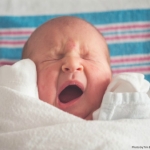A large body of literature indicates that adverse childhood experiences or ACEs can have negative, lasting effects on the physical and mental health of exposed children during childhood and later in life. Not only do ACEs have a negative impact on the exposed individual, ACEs affect future generations. Researchers hypothesize that there is an intergenerational transmission of risk from mother to child; however, we do know exactly how risk is transmitted from one generation to the next.
A recent study explores the association between maternal ACEs, neonatal brain development, and infant emotionality at six months of age. The sample included 85 mother-infant dyads (44 female infants) participating in the Care Project, a longitudinal study examining the impact of prenatal maternal mental health on offspring developmental outcomes.
Participants reported an average of 2.4 ACEs prior to the age of 18; 72% of reported experiencing at least one ACE. Maternal exposure to ACEs were assessed with the Adverse Childhood Experiences Questionnaire (ACE-Q). The researchers used magnetic resonance imaging (MRI) to measure neonatal hippocampal and amygdala volumes. Infant negative emotionality was assessed at 6 months using the Infant Behavioral Questionnaire (IBQ).
Maternal ACEs were associated with amygdala volume. Specifically, higher maternal ACEs were associated with smaller amygdala volumes. No significant associations were observed between maternal ACEs and hippocampal volume. At six months of age, the researchers observed that both high maternal ACEs and smaller left amygdala volume were associated with higher infant negative emotionality, although this mediation effect was not statistically significant.
This study demonstrates that maternal ACEs are associated with both newborn amygdala volume and subsequent infant negative emotionality. These findings provide evidence to support the intergenerational transmission of adversity from mother to child.
The results of this study are consistent with other studies demonstrating an association between maternal ACEs and reductions in offspring amygdala volume in older children (between 4 and 24 months old). Because the current study performed neuroimaging in children under 8 weeks of age (on average 5 weeks of age), it is likely that the observed changes in brain structure are attributable to changes in the prenatal environment, as opposed to exposures after delivery.
The specific mechanisms underlying the association between maternal ACEs and infant brain structure remain unclear. The transmission of maternal ACEs may occur through alterations in gestational biology, including endocrine and immune systems. Dysregulation of the hypothalamic-pituitary axis (HPA) has been implicated, given that HPA hormones, including cortisol and placental corticotropin releasing hormone (CRH), influence processes important in fetal brain development, including neurogenesis and dendritic growth.
Adverse childhood experiences are highly prevalent, with a recent study from the CDC indicating that 61% of adults surveyed experienced at least one adverse childhood experience and that women were more likely than men to experience four or more types of ACEs. Thus, ACEs are a critical public health issue. In addition, many with exposure to early childhood adversity experience the accumulation of multiple adversities during childhood, which is associated with especially deleterious effects on mental and physical health.
While multiple public health initiatives focus on the prevention of ACEs in children, future studies focusing on the transmission of risk between mother and child are also important. A better understanding of the prenatal environment and the mechanisms underlying transmission of risk may lead to targeted interventions which mitigate risk in children.
Ruta Nonacs, MD PhD
Demers CH, Hankin BL, Hennessey EP, et al. Maternal adverse childhood experiences and infant subcortical brain volume. Neurobiol Stress, Sept 2022.








Leave A Comment